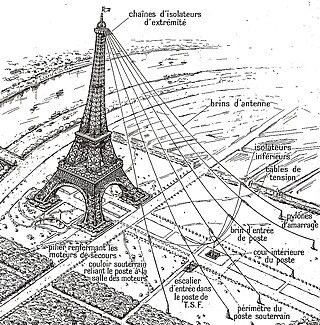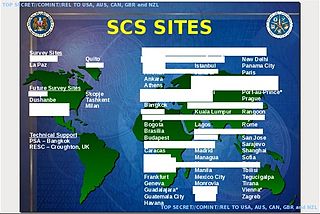
ECHELON, originally a secret government code name, is a surveillance program operated by the five signatory states to the UKUSA Security Agreement: Australia, Canada, New Zealand, the United Kingdom and the United States, also known as the Five Eyes.

Government Communications Headquarters (GCHQ) is an intelligence and security organisation responsible for providing signals intelligence (SIGINT) and information assurance (IA) to the government and armed forces of the United Kingdom. Primarily based at "The Doughnut" in the suburbs of Cheltenham, GCHQ is the responsibility of the country's Secretary of State for Foreign and Commonwealth Affairs, but it is not a part of the Foreign Office and its Director ranks as a Permanent Secretary.

The National Security Agency (NSA) is a national-level intelligence agency of the United States Department of Defense, under the authority of the Director of National Intelligence (DNI). The NSA is responsible for global monitoring, collection, and processing of information and data for foreign and domestic intelligence and counterintelligence purposes, specializing in a discipline known as signals intelligence (SIGINT). The NSA is also tasked with the protection of U.S. communications networks and information systems. The NSA relies on a variety of measures to accomplish its mission, the majority of which are clandestine. The NSA has roughly 32,000 employees.
A covert listening device, more commonly known as a bug or a wire, is usually a combination of a miniature radio transmitter with a microphone. The use of bugs, called bugging, or wiretapping is a common technique in surveillance, espionage and police investigations.
Wiretapping, also known as wire tapping or telephone tapping, is the monitoring of telephone and Internet-based conversations by a third party, often by covert means. The wire tap received its name because, historically, the monitoring connection was an actual electrical tap on an analog telephone or telegraph line. Legal wiretapping by a government agency is also called lawful interception. Passive wiretapping monitors or records the traffic, while active wiretapping alters or otherwise affects it.

The United States Agency for International Development (USAID) is an independent agency of the United States government that is primarily responsible for administering civilian foreign aid and development assistance. With a budget of over $27 billion, USAID is one of the largest official aid agencies in the world and accounts for more than half of all U.S. foreign assistance—the highest in the world in absolute dollar terms.

The Communications Security Establishment, formerly called the Communications Security Establishment Canada (CSEC), is the Government of Canada's national cryptologic agency. It is responsible for foreign signals intelligence (SIGINT) and communications security (COMSEC), protecting federal government electronic information and communication networks, and is the technical authority for cyber security and information assurance.

Arlington Hall is a historic building in Arlington, Virginia, originally a girls' school and later the headquarters of the United States Army's Signal Intelligence Service (SIS) cryptography effort during World War II. The site presently houses the George P. Shultz National Foreign Affairs Training Center, and the Army National Guard's Herbert R. Temple, Jr. Readiness Center. It is located on Arlington Boulevard between S. Glebe Road and S. George Mason Drive.

The Bureau of Diplomatic Security, commonly known as Diplomatic Security (DS), is the security branch of the United States Department of State. It conducts international investigations, threat analysis, cyber security, counterterrorism, and protection of people, property, and information. Its mission is to provide a safe and secure environment for officials to execute the foreign policy of the United States.
The Signal Intelligence Service (SIS) was the United States Army codebreaking division through World War II. It was founded in 1930 to compile codes for the Army. It was renamed the Signal Security Agency in 1943, and in September 1945, became the Army Security Agency. For most of the war it was headquartered at Arlington Hall, on Arlington Boulevard in Arlington, Virginia, across the Potomac River from Washington (D.C.). During World War II, it became known as the Army Security Agency, and its resources were reassigned to the newly established National Security Agency (NSA).

A radio listening station is a facility used for military reconnaissance, especially telecommunications reconnaissance by "intercepting" radio transmitter communications. In contrast to the original eavesdropping on an acoustic speech conversation, radio eavesdropping stations are used to eavesdrop on the information transmitted wirelessly using radio technology. For this purpose, highly sensitive radio receivers and suitable receiving antennas are used.

A Foreign Service officer (FSO) is a commissioned member of the United States Foreign Service. Foreign Service officers formulate and implement the foreign policy of the United States. FSOs spend most of their careers overseas as members of U.S. embassies, consulates, and other diplomatic missions, though some receive assignments to serve at combatant commands, Congress, and educational institutions such as the various U.S. service academies.

Hepting v. AT&T, 439 F.Supp.2d 974, was a class action lawsuit argued before the United States District Court for the Northern District of California, filed by Electronic Frontier Foundation (EFF) on behalf of customers of the telecommunications company AT&T. The plaintiffs alleged that AT&T permitted and assisted the National Security Agency (NSA) in unlawfully monitoring the personal communications of American citizens, including AT&T customers, whose communications were routed through AT&T's network.

The Special Collection Service (SCS), codenamed F6, is a highly classified joint U.S. Central Intelligence Agency–National Security Agency program charged with inserting eavesdropping equipment in difficult-to-reach places, such as foreign embassies, communications centers, and foreign government installations. Established in the late 1970s and headquartered in Beltsville, Maryland, the SCS has been involved in operations ranging from the Cold War to the Global War on Terrorism.
Vint Hill Farms Station (VHFS) was a United States Army and National Security Agency (NSA) signals intelligence and electronic warfare facility located in Fauquier County, Virginia, near Warrenton. VHFS was closed in 1997 and the land was sold off in 1999. Today the site hosts various engineering and technology companies, as well as two Federal Aviation Administration (FAA) air traffic control facilities.
Institute for the Study of International Migration is a private research institute located in Washington, DC. Founded in 1998 as part of Georgetown University's School of Foreign Service, it is associated with the Georgetown University Law Center. The Institute for the Study of International Migration (ISIM) is an innovative multidisciplinary center that studies the social, economic, environmental, and political dimensions of international migration.
Warrenton Training Center (WTC) is a classified United States government communication complex located in the state of Virginia. Established in 1951, it comprises four discrete stations located in Fauquier and Culpeper counties.
The Diplomatic Telecommunications Service (DTS) is a system of integrated telecommunications networks that supports foreign affairs agencies in Washington, D.C., and U.S. diplomatic missions abroad. It is administered by the United States Department of State Diplomatic Telecommunications Service Program Office (DTSPO). DTS is a global network of telecommunications sites that is charged with providing a global, reliable, and cost-effective communications network for the U.S. foreign affairs community.

STATEROOM is the code name of a highly secretive signals intelligence collection program involving the interception of international radio, telecommunications and Internet traffic. It is operated out of the diplomatic missions of the signatories to the UKUSA Agreement and the members of the ECHELON network including Australia, New Zealand, United Kingdom, Canada and the United States.












